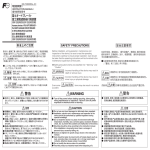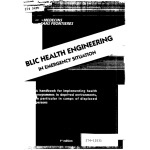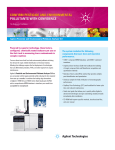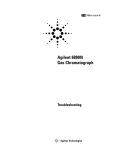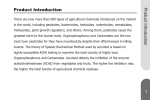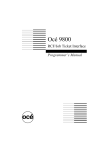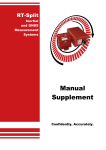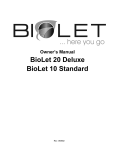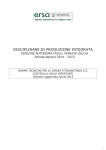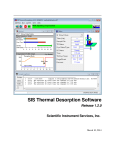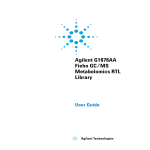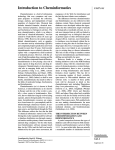Download (P&EP) Analyzer User Manual
Transcript
Agilent GC/MS/MS Pesticides and Environmental Pollutants (P&EP) Analyzer User Manual Agilent Technologies Notices © Agilent Technologies, Inc. 2015 Warranty No part of this manual may be reproduced in any form or by any means (including electronic storage and retrieval or translation into a foreign language) without prior agreement and written consent from Agilent Technologies, Inc. as governed by United States and international copyright laws. The material contained in this document is provided “as is,” and is subject to being changed, without notice, in future editions. Further, to the maximum extent permitted by applicable law, Agilent disclaims all warranties, either express or implied, with regard to this manual and any information contained herein, including but not limited to the implied warranties of merchantability and fitness for a particular purpose. Agilent shall not be liable for errors or for incidental or consequential damages in connection with the furnishing, use, or performance of this document or of any information contained herein. Should Agilent and the user have a separate written agreement with warranty terms covering the material in this document that conflict with these terms, the warranty terms in the separate agreement shall control. Manual Part Number G3445-90030 Edition Second edition, June 2015 Printed in USA Agilent Technologies, Inc. 2850 Centerville Road Wilmington, DE 19808-1610 USA Technology Licenses The hardware and/or software described in this document are furnished under a license and may be used or copied only in accordance with the terms of such license. Restricted Rights Legend If software is for use in the performance of a U.S. Government prime contract or subcontract, Software is delivered and licensed as “Commercial computer software” as defined in DFAR 252.227-7014 (June 1995), or as a “commercial item” as defined in FAR 2.101(a) or as “Restricted computer software” as defined in FAR 52.227-19 (June 1987) or any equivalent agency regulation or contract clause. Use, duplication or disclosure of Software is subject to Agilent Technologies’ standard commercial license terms, and non-DOD Departments and Agencies of the U.S. Government will receive no greater than Restricted Rights as defined in FAR 52.227-19(c)(1-2) (June 1987). U.S. Government users will receive no greater than Limited Rights as defined in FAR 52.227-14 (June 1987) or DFAR 252.227-7015 (b)(2) (November 1995), as applicable in any technical data. Safety Notices CAUTION A CAUTION notice denotes a hazard. It calls attention to an operating procedure, practice, or the like that, if not correctly performed or adhered to, could result in damage to the product or loss of important data. Do not proceed beyond a CAUTION notice until the indicated conditions are fully understood and met. WA R N I N G A WARNING notice denotes a hazard. It calls attention to an operating procedure, practice, or the like that, if not correctly performed or adhered to, could result in personal injury or death. Do not proceed beyond a WARNING notice until the indicated conditions are fully understood and met. Contents Introduction Analyzer Configurations 6 Where to Find More Information about Using your Pesticide Analyzer What’s on the Specials Factory Information CD ROM See Also 8 10 12 Operations Relocking the Data Acquisition Method Running the Checkout Sample 16 Reviewing Data and Generating a Report Columns and Supplies Troubleshooting 14 18 19 21 Appendix A – UltiMetal Plus Flexible Metal Ferrules Swaging Guide Parts Supplied 25 Tools Required 25 Preparing the Column Ends 26 Swaging Quality Inspection 29 Agilent GC/MS/MS P&EP Analyzer User Manual 3 4 Agilent GC/MS/MS P&EP Analyzer User Manual Agilent GC/MS/MS Pesticides and Environmental Pollutants (P&EP) Analyzer User Manual 1 Introduction Analyzer Configurations 6 Where to Find More Information about Using your Pesticide Analyzer What’s on the Specials Factory Information CD ROM 10 Agilent Technologies 8 5 Introduction Analyzer Configurations Identifying and quantifying dozens (or hundreds) of pesticides or organic pollutants in a wide range of fruit, vegetable, or environmental samples is a complex task. The Agilent GC/MS/MS Analyzer is a complete system that is factory configured and chemically tested to quickly identify a broad range of commonly analyzed pesticide and pollutant residues with ultimate sensitivity. The Analyzer comes with a Multiple Reaction Monitoring (MRM) database (p/n G9250AA, rev. A.1.01) that includes information for over 1000 pesticides and organic pollutants. The Analyzer is configured with Agilent’s proprietary Capillary Flow Technology, to provide rugged, reliable GC column backflushing. Backflushing the GC column shortens run times, extends column life, reduces chemical background noise, provides consistent retention times and spectra, and helps keep the MS ionization source clean. A Multi-Mode Inlet (MMI) provides the flexibility to inject samples in cold, hot, or solvent-vent modes allowing operators to optimize injection volumes to maximize mass on column. NOTE A split/splitless UI inlet option is available for laboratories that do not require maximal limit of detection (LOD) performance (Option #114). Each Analyzer system is tested using a 17-compound mixture and retention times for analysis locked at the factory. Four hardware configurations are available: G3445B-#411: Flexible Constant Pressure (CP) method: 40-min run, 30 m column x 0.5 m restrictor, post column backflush. G3445B-#415: Fast CP method: 20-min run, 15 m column x 0.5 m restrictor, post column backflush. 6 Agilent GC/MS/MS P&EP Analyzer User Manual Introduction G3445B-#412: Fast Constant Flow (CF) method: 20-min run, 15 m column x 15 m column, mid column backflush. Full screening CF method: 40-min run, 15 m column x 15 m column, mid-column backflush. G3445B-#414: Selective CF method: 20-min, 5 m column x 15 m column, mid column backflush. NOTE Notes for Analyzer option # 414: The #414 option is configured with a 240 V GC oven to allow for the rapid temperature rates in the oven and inlet programs). Add an additional 2 minutes hold time to extend the GC analytical run for late eluters (i.e. Imibenconazol, Cinidon-ethyl, Propaquizafop, Temephos, and Fluthiacet-methyl). The 2-mm dimpled liner (p/n 5190-2297) aids in minimizing column contamination due to non-volatile matrix deposits being retained on the dimples of the liner. Your Analyzer was configured and checked at the factory to ensure that your system is ready to run samples of value to your operation immediately after installation in your lab. The factory test results for your Analyzer can be found on the Specials Factory Information CD/DVD that shipped with your instrument. Agilent GC/MS/MS P&EP Analyzer User Manual 7 Introduction Where to Find More Information about Using your Pesticide Analyzer MRM Database DVD (G9250AA) The Pesticides and Environmental Pollutants MRM Database (G9250AA rev. A.1.01) now incorporates a new User Interface to provide a more streamlined approach to building a customizable Target List. From this list, the user interface then uses the information selected from the Database to develop an MRM acquisition method or MRM quantitation method. This exclusive 1074-compound MRM Database is included with your Analyzer as a separate DVD. The Database DVD also includes a few different documents and guides that outline the utility and operation of the Database. The G9250AA Rev. A.1.01 User Manual (G9250AA-90000.pdf) provides a tutorial of the new User Interface (see Figure 1 on page 9) that includes the following functions: • Building a Target Compound List • Developing an MRM Table • Exporting the MRM data to the CLA for acquisition optimization • Developing a Quant Method • Previous Functionality of the database 8 Agilent GC/MS/MS P&EP Analyzer User Manual Introduction Figure 1 The P&EP MRM Database new User Interface Home Screen Control Panel Application Notes and publications You can find more information about pesticide analysis in the application notes and publications included with your Specials Factory Information CD ROM. Alternatively, visit: http://www.chem.agilent.com/ and select the “Literature Library” under the Quick Links. QuEChERS extraction procedures and ready-to-use kits The QuEChERS extraction procedure for pesticide residues in fruits and vegetables is being used by labs around the world. For a training video, references, and ready-to-use kits for performing QuEChERS extractions, go to the following Agilent web site: http://quechersselectiontool.chem.agilent.com/ Alternatively, visit: http://www.chem.agilent.com/ and type QuEChERS into the search field. Agilent GC/MS/MS P&EP Analyzer User Manual 9 Introduction What’s on the Specials Factory Information CD ROM Your Pesticide Analyzer comes with a CD that contains the following information specific to your Analyzer Configuration: Analytical methods • The GC/MS/MS checkout methods: • 411_checkout_PCSL.M • 412_checkout_PCSL.M • 414_checkout_SV.M • 415_checkout_PCSL.M (These methods are either a pulsed-cold-splitless or a solvent-vent MRM method with 17 analytes and is retention time locked at the factory.) NOTE Another GC/MS/MS method is included as a reference (415_checkout_HSL.m). This is a hot-splitless MRM method with 17 analytes and is NOT retention time locked at the factory. • The GC/MS/MS general pesticide analysis methods: • Pulsed_cold_splitless.M • Hot_splitless.M • 414_SV.M • 415_PCSL.M or 415_HSL.M NOTE If you do not have a MultiMode Inlet (MMI) installed, you should use the hot-splitless method (Hot_splitless.m) instead of the pulsed-cold-splitless method for the inert split/splitless inlet. • The signal-to-noise data analysis methods: • 411_signal-to-noise.M • 412_signal-to-noise.M • 414_signal-to-noise.M • 415_signal-to-noise.M Copy the Factory Methods and Test Results to the Hard Drive D:\MassHunter\GCMS\1\ Method. 10 Agilent GC/MS/MS P&EP Analyzer User Manual Introduction NOTE Edit the Msdchem.ini file in the C:\GCMS\msexe folder to show, for example: _METHFILE$=411_checkout_PCSL.m, so this method will be loaded as you bring up the 7000 acquisition software, without going through Method Resolution. NOTE The qqqacqmethod.xml file in each method folder has all the MRM transitions for the method. Data files and reports • Checkout sample data files: • 411_checkout_PCSL_1µL.D • 412_checkout_PCSL_1µL.D • 414_checkout_SV_1µL.D • 415_checkout_PCSL_1µL.D Copy the checkout data file from the Specials Factory Information CD ROM to D:\MassHunter\GCMS\1\Data. • Report, QuantReport_ESTD_ResultsSummary.xlsx, obtained at the factory for a 1-µL injection of the 100 ppb GC/MS/MS Analyzer Checkout Sample (p/n 5190-0494) Reference materials • Agilent Application Notes that discuss pesticide analysis • A copy of this User Manual • Corresponding technical guides and tutorials • A list of target pesticides (G9250AA_pesticide_MRM_database_compound_list.pdf) MRM database and Excel spreadsheet • The G9250AA (rev. A.1.01) Pesticides and Environmental Pollutants MRM database • The Excel spreadsheet (RT_locking_calculator.xlsx) for calculating the proper inlet flow to relock the Chlorpyrifos Methyl peak for the method of choice is still included for optional use Agilent GC/MS/MS P&EP Analyzer User Manual 11 Introduction See Also Document files: • MRM Database G9250AA Rev. A.1.01 Help file: G9250AA_Help.pdf • MRM Database G9250AA Rev. A.1.01 ReadMe file: G9250AA_ReadMe.pdf • MRM Database G9250AA Rev. A.1.01 Quick Start Guide: G9250-90010.pdf • MRM Database G9250AA Rev. A.1.01 User Manual: G9250-90000.pdf • The Pesticides and Environmental Pollutants (P&EP) GC/MS/MS 3.0 Application Note: 5991-4419EN.pdf Tutorial video: Adding Compounds (Adding Compounds.MP4; located on G2950AA MRM Database DVD) 12 Agilent GC/MS/MS P&EP Analyzer User Manual Agilent GC/MS/MS Pesticides and Environmental Pollutants (P&EP) Analyzer User Manual 2 Operations Relocking the Data Acquisition Method 14 Running the Checkout Sample 16 Reviewing Data and Generating a Report 18 Columns and Supplies 19 Troubleshooting 21 Agilent Technologies 13 Operations Relocking the Data Acquisition Method Mass Hunter GC-MS Acquisition software Rev. B.07.00 SP2, or later, can perform the automated Retention Time Locking (RTL) calibration for constant flow methods. With the release of the P&EP 3.0, the automated Retention Time Locking (RTL) calibration process includes both RT Locking for both constant pressure (CP) and constant flow (CF) methods. NOTE The RT_locking_calculator.xlsx is being supplied with the Analyzer CD/DVD for informative purposes only. The calculator spreadsheet does not need to be used for relocking the method and has not been used during the instrument checkout in the factory. Relocking Following replacement or trimming of the GC column, Agilent recommends that you relock you analyzer method to eliminate the need for time segment adjustments in your acquisition method. 14 1 To relock a method, select Relock Method… from the GC/MS/MS data acquisition Method menu and enter the required information to start a run. The target retention time for the Chlorpyrifos Methyl peak is 16.593, 9.143, 8.524, or 8.297 minute. See Table 1 on page 17 for corresponding methods and retention times. 2 Follow the steps to obtain the lock pressure/flow. 3 Enter the lock pressure/flow from the above relocking process into your acquisition methods. 4 Save the method with the new locked pressure/flow. Agilent GC/MS/MS P&EP Analyzer User Manual Operations NOTE The use of RT_locking_calculator.xlsx is not needed with current GC/MS Acquisition software; but it is still supplied for informative purposes. If used: 1 Obtain the RTLOCK data files in Method (.M) folder. 2 Write down the retention times and pressures/flows of Chlorpyrifos Methyl (transition ion(s) 208,93). 3 Record the retention time and pressure/flow of data file that was just obtained. (For the flow calculations, use Column 1 to set the RTs). 4 Enter the recorded values into their respected cells in the calculator. (Note: make sure the “Desired Locking RT” is accurate for the method of choice; see Table 1 on page 17.) 5 Enter the calculated locking RT pressure/flow into the Method for column 1. (Note: for a constant flow method, the column 2 flow setting = column 1 + 0.2 mL/min) Auto Retention Time Locking (RTL) This Analyzer’s Chromatographic analysis is retention time locked at the factory. The retention time of the Analyzer can be automatically locked using either a full-scan method or an MRM method. To lock a method, select Acquire RTLock Calibration Data… from the GC/MS/MS data acquisition Method menu. The system will automatically make 5 injections with varying inlet pressures or flows to change the retention time of a locking compound. If you are using an MRM method, make sure the locking compound transitions are in all the time segments where the peak will show up due to the adjustment of inlet pressure or flow. Specify acquired ion(s) from scan (125,286) or MRM (208,93) in the RTL process if the locking compound is Chlorpyrifos Methyl. Agilent GC/MS/MS P&EP Analyzer User Manual 15 Operations Running the Checkout Sample At the factory, your system was chemically tested by making 1-µL injections of a 100 ppb 17 compound checkout standard. The Specials Factory Information CD ROM contains a copy of the exact method used during factory checkout: • 411_checkout_PCSL.M • 412_checkout_PCSL.M • 414_checkout_SV.M • 415_checkout_PCSL.M Chromatography for your specific method was retention time locked (RTL) at the factory. At installation, Agilent’s service engineer will verify chromatographic performance and relock the method. The Analyzer Checkout Sample contains 17 pesticides shown in Table 1. The concentration of each pesticide is 100 ppb (100 pg/µL) in acetone. Please note that most of the pesticides used to make up this sample were >97% pure, meaning that there are some small impurities or isomers of the major components may be present. To run the checkout sample: 1 Load the specified checkout method: • 411_checkout_PCSL.M • 412_checkout_PCSL.M • 414_checkout_SV.M • 415_checkout_PCSL.M 2 Make a 1-µL Injection of the 100-ppb Checkout Sample (p/n 5190-0494). 3 Name the Data File: • 411_checkout_PCSL_1µL.D • 412_checkout_PCSL_1µL.D • 414_checkout_SV_1µL.D • 415_checkout_PCSL_1µL.D 4 16 Save the files in D:\MassHunter\GCMS\1\Data. Agilent GC/MS/MS P&EP Analyzer User Manual Operations Table 1 Pesticides contained in the 100 pg/µL checkout sample (p/n 5190-0494) Retention Time (min) Name CAS # Opt # 411 ~40 min Opt #412 ~40 min ~20 min Opt # 414 Opt # 415 ~20 min ~20 min Dichlorvos 62-73-7 5.831 6.188 4.679 4.032 2.915 Mevinphos 7786-34-7 7.595 9.070 5.610 4.845 3.803 Ethalfluralin 55283-68-6 11.283 13.590 7.139 6.383 5.654 Trifluralin 1582-09-8 11.637 13.945 7.247 6.511 5.831 Atrazine 1912-24-9 13.159 15.321 7.887 7.149 6.576 Chlorpyrifos Methyl (Locking Compound) 5598-13-0 16.593 18.110 9.143 8.524 8.297 Heptachlor 76-44-8 16.796 18.299 9.339 8.663 8.387 Malathion 121-75-5 18.800 19.654 9.729 9.289 9.404 Dieldrin 60-57-1 23.870 23.391 11.717 11.438 11.940 p,p'-DDE 72-55-9 24.021 23.418 11.612 11.441 12.018 Hexazinone 51235-04-2 27.385 26.665 13.195 13.349 13.703 Propargite 2312-35-8 27.725 27.033 13.318 13.572 13.876 Mirex 2385-85-5 29.835 29.633 14.872 14.624 14.944 Fenarimol 60168-88-9 30.403 30.320 15.084 14.831 15.237 Coumaphos 56-72-4 31.667 31.979 15.853 15.410 15.871 Etofenprox (Ethofenprox) 80844-07-1 33.203 33.912 16.777 16.245 16.650 Deltamethrin 36.001 36.506 18.117 17.582 18.048 52918-63-5 Agilent GC/MS/MS P&EP Analyzer User Manual 17 Operations Reviewing Data and Generating a Report 1 Open MassHunter Qualitative Analysis (Qual). 2 Select File > Open Data File… to load the data file: • 411_checkout_PCSL_1µL.D • 412_checkout_PCSL_1µL.D • 414_checkout_SV_1µL.D • 415_checkout_PCSL_1µL.D 3 Select Method > Open… to load the signal-to-noise method: • 411_signal-to-noise.M • 412_signal-to-noise.M • 414_signal-to-noise.M • 415_signal-to-noise.M NOTE 18 4 Select Actions > Run the Worklist Actions. 5 Open the PDF report in the Reports folder within the data file folder. If all signal-to-noise ratios (of Mirex) are greater than 2500, this system is ready for running samples. 6 Compare your report with the factory report for the checkout sample generated for this specific Analyzer. The results from the factory are on the Specials Factory Information CD ROM. Relock the method if the Chlorpyrifos Methyl peak is more than ± 0.015 minute different than the method's locking compound retention time of 16.593, 9.143, 8.524, or 8.297 minute (see Table 1 on page 17 for corresponding methods and retention times). See “Relocking the Data Acquisition Method” on page 14. Agilent GC/MS/MS P&EP Analyzer User Manual Operations Columns and Supplies Table 2 Columns and column accessories Description Part number installed extra Siltek deactivated Fused Silica 5 m x 0.15 mm, flow restrictor (# 411 and # 415 Analyzers) 160-7626-5 0.7 m 4.3 m Agilent J&W HP-5ms Ultra Inert GC Column, 30 m × 0.25 mm × 0.25 µm (# 411 Analyzer) 19091S-433 UI 1 0 Agilent J&W HP-5ms Ultra Inert GC Column, 15 m × 0.25 mm × 0.25 µm (# 414 and # 415 Analyzers) 19091S-431 UI 1 0 Agilent J&W HP-5ms Ultra Inert GC Column, 15 m × 0.25 mm × 0.25 µm (# 412 Analyzer) 19091S-431 UI 2 0 Agilent J&W HP-5ms Ultra Inert GC Column, 5 m × 0.25 mm × 0.25 µm (# 414 Analyzer) G3903-61005 1 0 Column ferrule, MMI, graphite (10/pkg) 5080-8853 1 1 pkg Column nut, GC capillary (2/pkg) 5181-8830 1 1 Swaging nut for MS interface OR Column nut for MS interface G2855-20555 1 0 05988-20066 1 0 MS interface ferrule (15% graphite/85% Vespel) 0.25 mm (10/pkg) 5062-3508 1 1 pkg Inlet liner (4-mm Ultra Inert liner, Splitless, single taper, wool – hot splitless injections) 5190-2293 1 0 Inlet liner (2-mm Ultra Inert liner, Splitless, single taper, dimpled – cold splitless injections) 5190-2297 1 0 O-ring, inlet liner, non-stick (10/pkg) 5188-5365 1 1 pkg Septum, advanced green (50/pkg) 5183-4759 1 1 pkg GC inlet and instrument supplies Agilent GC/MS/MS P&EP Analyzer User Manual 19 Operations Table 2 Columns and column accessories (continued) Description Part number installed extra Big universal trap for helium purification RMSH-2 2 0 Universal/External split vent trap (includes 3 cartridges) RDT-1020 0 0 Split Vent Trap PM kit 5188-6495 0 0 Internal nut for capillary flow device (installed on purged ultimate union) G2855-20530 2 2 (plugs) Flexible metal ferrule, UltiMetal Plus, 0.4 mm id, for 0.1 to 0.25 mm ID (10/pkg) G3188-27501 2 1 pkg 1/16-inch Brass Swagelok tee 0100-0680 1 0 Bleed line, 0.0625-in OD × 0.010-in ID × 100 cm, 316SS tubing 0100-2354 1 0 Bleed tee ferrule, 1/16-inch Vespel (10/pkg) 0100-1329 3 7 pieces Column installation tool G1099-20030 0 1 Capillary tubing cutter (4/pkg) 5181-8836 0 1 Pesticide analyzer checkout sample (17 pesticides at 100 pg/µL each in acetone) 5190-0494 0 1 QuEChERS EN method sample pack 5982-7000 0 1 QuEChERS AOAC method sample pack 5982-7005 0 1 Backflush and capillary flow device supplies Useful tools and chemical standards Sample preparation Additional QuEChERS extraction supplies at www.agilent.com/chem/quechers. 20 Agilent GC/MS/MS P&EP Analyzer User Manual Operations Troubleshooting Use existing Data files to Lock If you have acquired all calibration runs and there was a problem of picking up the integrated peak, etc., you can simulate the retention time locking process without rerunning the complete RTL data set: 1 Load the method. 2 Use Qual to evaluate all data files inside the RTLOCK folder, select 1-2 representative ions of the locking compound. 3 Make sure the locking compound EIC can be properly integrated. 4 In command line type: acqlock 1,1 (there is a space before 1,1). 5 You will see normal RTL message box and also the message that previous RTL datafiles will be lost. This command simulated the locking process and you should answer Yes. It will use existing data files in the evaluation. 6 Next, you should see normal locking screens, complete these and the method is locked. If you want to relock the method by using an existing data file, you can simulate this as well: 1 Load the method. 2 Make sure that data file name and folder is assigned in run method screen. 3 In command line type: acqlock 2,1. Before executing the command, make sure that the method is loaded and data file name and data path are entered properly. 4 You will see normal relock windows and following these compete the locking. Agilent GC/MS/MS P&EP Analyzer User Manual 21 Operations Auto RTL failed Incomplete RTL Calibration information Ion signals too weak – MassHunter cannot integrate them Use MassHunter Qual to examine all 5 locking data files inside the method folder. Use > 1 ppm standards or set a higher electron multiplier Gain value if the ion signals are weak. The r2 value is less than 0.95 Use MassHunter Qual to examine all 5 locking data files inside the method folder. Make sure the locking compound exists in all 5 runs. If not, make sure the locking compound transitions exist in all relevant time segments. The ions entered for MassHunter identification are incorrect Use MassHunter Qual to review the RTL data files and identify the ions acquired and then execute acqlock 1,1 in GC/MS/MS Acquisition command line to lock. This command will reprocess the 5 previously collected data files. More troubleshooting Complaint: files take up a lot of space Remember that every data file includes the acquisition method; so if the method is locked, each data file also includes the six calibration files. Workaround: • Backup the D:/masshunter/gcms/1/hst.ini file • Open the original hst.ini file in the notepad and modify following line • [copymethod] • enabled=0 • Save the hst.ini file • Method is not saved under the data files anymore If instrument is reconfigured, this file is overwritten. 22 Agilent GC/MS/MS P&EP Analyzer User Manual Operations The GC never comes ready or the sequence halted Make sure all pressure setpoints can be reached or are properly ignored. Fix all leaks, increase gas supply pressure, and configure the purged ultimate union to Ignore Ready = True. Checking for leaks Checking air leaks at MS transfer line connection Spray the MS transfer line nut with a fluorinated aerosol duster, for example, Miller-Stephenson MS-222N Aero-Duster, and look for ions 69 and 83 from 1,1,1,2-Tetrafluoroethane, CAS 811-97-2. Leak free connections UltiMetal Plus Flexible Ferrules provide a leak-free seal using less torque, reducing column breakage, and are treated with UltiMetal Plus deactivation for an inert flow path. See also • Flexible Metal Ferrule Touchless Package Video Wide opening and new dial pack design allows Touchless installation as column is threaded through ferrule easily http://www.chem.agilent.com/en-US/products-services/Part s-Supplies/Chromatography-Spectrometry/GC-and-GC-MS/ UltiMetal-Plus-Flexible-Metal-Ferrules/Pages/PackageInstru ctions.aspx • Flexible Metal Ferrule Column Connections Video http://www.chem.agilent.com/en-US/products-services/Part s-Supplies/Chromatography-Spectrometry/GC-and-GC-MS/ UltiMetal-Plus-Flexible-Metal-Ferrules/Pages/flexiferrulepr eswag.aspx or http://youtu.be/3GkmiVvydeI This video demonstrates column connections using the Agilent Ultimetal Plus Flexible Metal Ferrules. Three steps are presented: 1 Pre-swaging. 2 Column trimming and quality inspection. 3 Connecting to capillary flow devices. Agilent GC/MS/MS P&EP Analyzer User Manual 23 Operations 24 Agilent GC/MS/MS P&EP Analyzer User Manual Agilent GC/MS/MS Pesticides and Environmental Pollutants (P&EP) Analyzer User Manual Appendix A – UltiMetal Plus Flexible Metal Ferrules Swaging Guide Parts Supplied The available UltiMetal Plus Flexible Metal ferrule packages are listed in Table 3 and Figure 2. Table 3 Available UltiMetal Plus Flexible Metal ferrule packages Item Part number Ferrule description 1 G3188-27501 0.1 – 0.25 mm column id, 10/pk 2 G3188-27502 0.32 mm column id, 10/pk 3 G3188-27503 0.45 – 0.53 mm column id, 10/pk 4 G3188-27504 Plug, 10/pk 5 G3188-27505 0.25 – 0.32 mm UltiMetal column id, 10/pk 6 G3188-27506 0.53 mm UltiMetal column id, 10/pk 1 2 Figure 2 3 4 5 6 UltiMetal Plus Flexible Metal ferrules Each UltiMetal Plus Flexible Metal ferrule part number is uniquely designed to prevent inventory mix-ups, and to help you find the ferrule you need quickly. Color variations between ferrules are a normal result of the UltiMetal coating. Tools Required • Two 1/4-inch open-end wrenches • Column cutting tool • Swaging wrench Agilent Technologies 25 Appendix A – UltiMetal Plus Flexible Metal Ferrules Swaging Guide Preparing the Column Ends 1 Pass the column end through the internal nut, the ferrule, and the swaging wrench (see Figure 3). Figure 3 2 Thread the internal nut into the swaging wrench with the column protruding out of the back of the wrench (see Figure 4). Figure 4 26 Thread the column through the internal nut, ferrule, and swaging wrench Thread the internal nut onto the swaging wrench Agilent GC/MS/MS P&EP Analyzer User Manual Appendix A – UltiMetal Plus Flexible Metal Ferrules Swaging Guide 3 Begin to swage the ferrule to the column using a 1/4-inch open-ended wrench. The design of UltiMetal Plus Flexible Metal ferrules reduces the probability of column breakage and minimizes the damage to the thread of the corresponding fittings. Unlike other ferrule designs, a reliable leak-free seal is best made by tightening the internal nut to a recommended number of degrees, not by applying more force. Applying excessive force will not provide a better seal. Also, compressing the flexible ferrule less minimizes damage to fittings. To swage the ferrule to the column: a Find your ferrule type in Table 4 and note the range of degrees to tighten the internal nut. b Tighten the internal nut clockwise to the lower end of your ferrule’s range. c Check if the ferrule is gripping the column. If yes, stop. If not, continue to tighten the internal nut in small 5- to 15-degree increments. Check after each increment to see if the ferrule is gripping the column. Stop as soon as gripping occurs (see Figure 5 on page 28). Table 4 Degrees to tighten the internal nut for proper swaging Ferrule part number Degrees to tighten internal nut G3188-27501 50 – 100 degrees G3188-27502 30 – 70 degrees G3188-27503 20 – 50 degrees G3188-27504 60 degrees G3188-27505 40 – 90 degrees G3188-27506 20 – 50 degrees Agilent GC/MS/MS P&EP Analyzer User Manual 27 Appendix A – UltiMetal Plus Flexible Metal Ferrules Swaging Guide Figure 5 4 Using the 1/4-inch open-ended wrench, turn the internal nut an additional 15 to 20 degrees clockwise to ensure the ferrule is properly swaged onto the column (see Figure 6). Figure 6 5 28 Tightening the internal nut Ferrule swaged to column and internal nut Using the 1/4-inch open-ended wrench, remove the internal nut from the swaging wrench and column. Agilent GC/MS/MS P&EP Analyzer User Manual Appendix A – UltiMetal Plus Flexible Metal Ferrules Swaging Guide 6 Using the column cutter, trim the column at the small end of the ferrule leaving approximately 0.3 mm of the column extending from the ferrule (Figure 7). The minimum size of the column head extending from the ferrule is 0.1 mm and the maximum is 0.5 mm. It is important to have 0.5 mm or less column head to prevent column conflict in the union. Figure 7 Properly-trimmed column and ferrule Swaging Quality Inspection Figure 8 shows both an incorrect and correct swaging symmetry. Incorrect Figure 8 Correct Incorrect and correct swaging symmetry If your column and ferrule look like the incorrect example in Figure 8 above, it is possible that your swaging wrench is defective or worn out. Try swaging with a new wrench or new nut. Agilent GC/MS/MS P&EP Analyzer User Manual 29 Appendix A – UltiMetal Plus Flexible Metal Ferrules Swaging Guide 30 Agilent GC/MS/MS P&EP Analyzer User Manual Agilent Technologies © Agilent Technologies, Inc. Printed in USA, June 2015

































